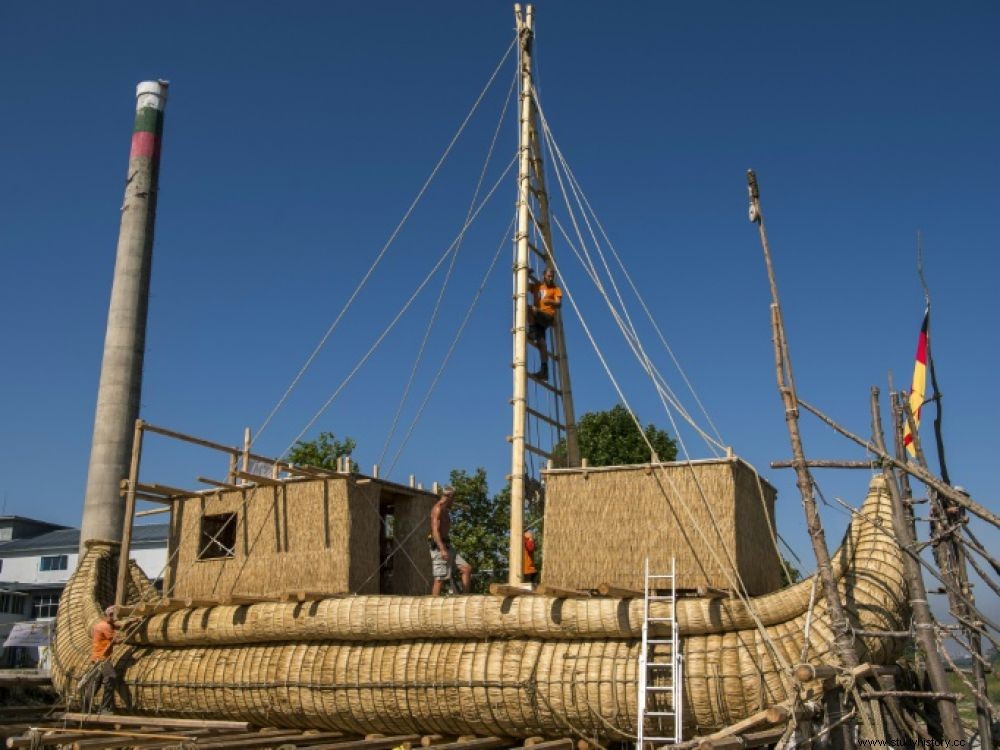Were the Egyptians able to cross the Mediterranean on papyrus boats more than 4,000 years ago to the Black Sea? To test this hypothesis - which is far from unanimous - researchers are preparing to attempt this odyssey on a boat they have reconstructed in Bulgaria.

The "Arbora IV" nave, made entirely of reeds, on July 25, 2019 in Beloslav, Bulgaria
Patiently assembled by an international team in Beloslav near Varna on the Bulgarian coast, the 'Arbora IV', a longship-shaped nave, is about to be launched ahead of a scheduled departure mid- August 2019. According to the German researcher Dominique Goerlitz, at the origin of the project, the Egyptians crossed the Mediterranean to the Black Sea to obtain the metal necessary for the construction of their monumental pyramids.
Crossings from the Neolithic
The hypothesis is far from achieving consensus among scientists (see our box) but is, according to Mr. Goerlitz, accredited by the writings of the Greek historian Herodotus. At this point, "with Arbora IV, we want to prove that such a trade was possible from the end of the Neolithic ", he explains to AFP. All that remained was to build the boat. Almost a routine for this German experimenter who was already behind three similar projects, including an attempt to cross the Atlantic in 2007. New York, the Arbora III had almost reached the Azores before falling victim to a storm after 56 days at sea.
As for this previous project, the researcher relied on the project management of Aymara Indians from Lake Titicaca, in the Bolivian Andes, Fermin Limachi and his son Yuri, whose tribe has cultivated until today the he art of making boats – and even artificial islands – out of reed. The result is quite impressive:14 meters long, the Arbora IV gives off an impression of robustness and even relative comfort, with its two large cabins. Equipped with a wooden mast, they have two linen sails of 62 and 40 square meters. In total, two kilometers of rope were needed to bind the 12 tons of reeds used into bundles, specifies Fermin Limachi, whose father José had been associated in 1970 with the adventure of Râ II by the Norwegian Thor Heyerdahl, one of the first attempts of experimental maritime archaeology. As the papyri used by the ancient Egyptians no longer grew in sufficient quantity, the Arbora IV was built with totora reeds imported... from Lake Titicaca.
WOOD RATHER THAN REED
The discovery of the old ports and the information provided by the "papyri of the Red Sea", one of the greatest archaeological discoveries made in recent years (see Sciences et Avenir n°857, July 2018) have made it possible to establish that, contrary to what was previously thought, the Egyptians had great mastery of the sea and shipyards from 3000 BC! The monumental undertaking of the construction of the pyramids is at the origin of the explosion of maritime activity. Whether on the Nile or the Red Sea, the vast majority of boats were intended for the transport of raw materials. With a singularity:they were dismantled wooden boats transported in spare parts from one point to another of the country. To do this, the Egyptians used a double construction technique:assemblies by tenons and mortises, and by ligatures. Braided papyrus ropes bound together the different parts of the boat, whether planks or frame elements. The gods not having endowed Egypt with sufficiently large trees, these "sewn boats", intended to navigate both at sea and on rivers, were built with acacia and cedar wood imported from the land of Canaan. (Lebanon) or Cyprus. This is the case of the large funeral ship of Kheops unearthed in 1952, with its 43m length as much as the boats unearthed on the sites of Abydos and Abu Rawash. Each piece was numbered for ease of assembly
Mini air chambers
The objective is now to see if the skiff will manage to escape the dangers during the approximately 700 nautical miles (1,300 km) of its future crossing to Crete, its objective. "The main question is whether this papyrus boat is able to withstand the raging winds in the Cyclades and the Aegean Sea ", recognizes Mr. Goerlitz. During the days following the launching, the reeds constituting the boat will have absorbed more than 5 tons of water, which will ensure its ballast and its future stability at sea, underlines the researcher .
According to him, despite seemingly rudimentary technology, the boat has incomparable buoyancy because the reeds offer it "billions of mini air chambers and it cannot break and sink all at once.> ". Modernity obliges, the crew made up of volunteers from eight countries will have during its crossing means of satellite and radio communication, essential to avoid a collision with other vessels. "It would be totally arrogant and stupid to pass ", believes Mr. Goerlitz, according to whom "a cargo ship is more dangerous than a storm on the open sea ".
Mark Pales, a 42-year-old Dutch electrician working on the project on a voluntary basis, says he has no doubts about the safety offered by the Arbora IV. "I'm 100% sure it will never sink ", he claims. In the worst case, "as long as it floats, it will act as a rescue raft ". Heike Vogel, a 35-year-old German volunteer, also makes no secret of her impatience to get on board. "It's going to be a very exciting and unique experience for me ", she underlines.
